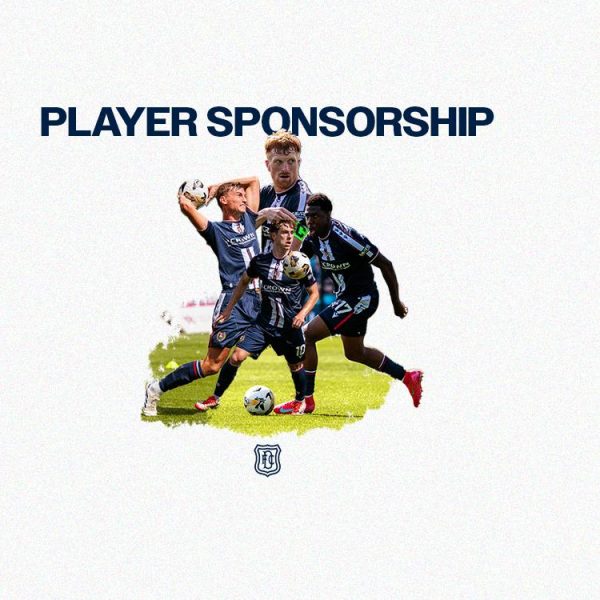When football finally resumes when the current pandemic dissipates, it will be the longest gap without football at Dens Park since the end of the Second World War but when football returned at the end of that conflict, Dundee Football Club enjoyed the most successful period in its distinguished history.
Like today Dundee found themselves in the second tier of Scottish football when the League resumed and the Dark Blues would go onto win back to back ‘B’ Division titles before they were granted promotion and followed that up with a runners-up spot in the ‘A’ Division two years later. In 1951 and 1952, Dundee won their first silverware since 1910 with two League Cup victories, becoming the first club to successfully retain it and sandwiched in between those victories was a Scottish Cup Final appearance, making it three major cup finals in a row. Add to that four Forfarshire Cups, three Dewar Shields and four Inter-City Cups, a total of fifteen trophies were won between 1945 and 1952. It truly was a golden era at Dens Park.
George Anderson transformed Dundee after he became manager in 1944 and turned them into a major force in Scottish Football. He got the reward for his ‘think big’ policy when Dundee defeated Rangers in the 1951 League Cup Final and history was made when that success was repeated against Kilmarnock twelve months later.
With the 1952 Scottish Cup Final also reached it meant the Dark Blues had appeared in three Hampden Finals in a row and a generation of Dundee fans had their first ever Hampden Heroes to worship. Never before had Dark Blues won a trophy at the National Stadium, with the club’s only other success a Scottish Cup win over Clyde at Ibrox in 1910 and now they had done it twice in quick succession. It was a wonderful achievement.
Anderson built a wonderful side with some of the finest players to ever grace not only Dens Park but also Scottish Football. Amongst them was superstar Billy Steel for whom Dundee paid a world record fee, who could turn a game in an instant with his fantastic array of skill; there was the potent centre-forward Bobby Flavell, a football outcast who returned to Scotland to score in two League Cup Finals for The Dee; Bill Brown, the wonderfully agile keeper amongst the greatest custodians Scotland has ever produced and there was the famous half-back line of Tommy Gallacher, Doug Cowie and Alfie Boyd upon whom much of the success was built.
The local press nicknamed them the ‘League of Nations’ as Dundee led the way with bringing in players from different countries; most notably an elegant South African full back named Gordon Frew, his countryman Ken Ziesing who was a powerful centre forward before he was converted into a wing half at Dens and a left back, Jack Cowan, a rangy Canadian who became his continental player of the year in 1951. Anderson made Dundee a power in the land by shrewd signings, a public relations touch ahead of his time and a fantastic team to boot who played some scintillating football.
Although the Scottish League suspended its competition immediately upon the declaration of War in September 1939, it soon became clear that football would help sustain the morale of the nation and by October, new regional leagues were formed. Dundee entered into the new Eastern Division as crowds were limited to 8,000 for fear of German air-raid attacks, but The Dee struggled to compete as players either volunteered for military service or were called up. With an average crowd of just 3000 and a £1,400 financial loss for the season, Dundee decided in May 1940 to close for the duration of the conflict and Dens Park was used by the Decontamination (Food) Service until football resumed four years later.
The break however was vital for the restructuring and future of Dundee Football Club as, during this period, directors William Hood, Robert Paterson and James Meechan retired and vice-chairman David How died. The shares of Simpson and How were purchased by a local consortium and at the club’s A.G.M. in April 1944, a new board was elected with consortium members John Thomson, James Gellatly, Murray Wilkie, Jack Swadel and – most significantly – George Anderson co-opted onto the board. With the tide of the war turning in the Allies’ favour, preparations began in August 1944 for Dundee to resume playing football with George Anderson placed in charge of team affairs.
Anderson had been a director of his hometown club Aberdeen and had been put in charge of team affairs at Pittodrie when manager (and Dundee goalscoring legend) Davie Halliday went off to war. Anderson revelled in the position of caretaker-manager but as the job was being held open for the return of Halliday, Anderson made a move for the position at Dens. He had guested for Dundee during the First World War and now used his many contacts to build a new team so when Dundee returned to play in the Scottish League North East Division in October 1944, the team contained only two players who had played in the final game four years earlier.
On August 5th 1944, two months after the D-Day landings, Dundee returned to action against the British Army, in effect an almost entirely international eleven which included Matt Busby, Joe Mercer and Frank Swift. Despite The Dee going down 7-0, Busby complimented their “cultured style of play” and a week later, Dundee opened their league campaign in Kirkcaldy against Raith Rovers.
Dundee won the Scottish League North East Division First Series in 1944/45 and the Scottish League ‘B’ Division the season after but the club had to wait until it had won a third ‘championship’ in a row in 1946/47 before it was granted promotion. Due to the large number of guest players used by clubs and the number of players still being demobbed, the Scottish League decided not to re-insert promotion or relegation until 1947. After ten years out of the top flight, the Dark Blues were back in the big time for the start of the 1947/48 campaign and Anderson was the toast of the city.
Anderson, known affectionately as ‘Toffee Dod’ because of the confectionery business he ran in the Granite City, showed himself to be a forward planner and a progressive football thinker. He had constantly been gearing Dundee for life in the top flight and had been signing players with the ‘A’ Division in mind. Amongst those signings were future League Cup winning captain Alfie Boyd, club appearance record holder Doug Cowie and 2011 DFC Hall of Fame Inductee Tommy Gallacher, who had turned out for The Dee during the war.
Anderson also recruited English centre-forward Albert Juliussen who would write his name into the history books at Dens Park when, in consecutive games, he scored ‘double’ hat-tricks. On March 8th 1947, ‘Big Julie’ scored six goals at Alloa Athletic in a 10-0 win before bettering that in the next game a fortnight later with seven in a 10-0 victory at home to Dunfermline. Dundee would score a club record 113 goals on the way to winning their second ‘B’ Division title and those 10-0 wins still stand today as the club’s highest ever victories.
Anderson was a master of man management and popular with the players with his emphasis on ball-work at training which was unusual at that time. He excelled in public relations and attempted to raise the profile of the club, but more importantly had an eye for talent and had constructed a skilful, attractive side in a relatively short space of time. So much so, that they were now ready for an assault on Scotland’s elite.
Anderson still lived in Aberdeen where he was a town councillor and he travelled down to Dundee twice a week. The day-to-day training was left to assistants Willie Cameron and Andy McCall but the bowler-hatted, bow-tied, larger-than-life Anderson had the full support and respect of the players despite his infrequent appearances at the club.
It is said that Anderson would tell the players to ‘go out and enjoy themselves’ on a Saturday afternoon and he liked to encourage attractive football. Dundee’s first season back in the top flight was rewarded with a fourth-placed finish in a sixteen-team league, their highest placing in twenty-six years and there were some memorable results along the way including a 4-1 home win over Celtic, a 6-0 win over Airdrie and a 7-0 win over Clyde. Perhaps the best result of all however was a 3-1 home win over champions Hibernian on the last day of the season and it served notice that Dundee themselves were ready for an assault on the title.
In pre-season Anderson announced that none of his players were for sale and that young talent would be nurtured and the club practised exactly what Anderson preached. Of Dundee’s thirty-two man squad for the 1948/49 season, twenty had been signed from juveniles or Juniors and several had been recruited from local clubs. Anderson had signed players from his home base in Aberdeen, including Doug Cowie, Syd Gerrie and young forward George Christie, whom he spotted playing for Banks O’Dee Juniors and to whom he gave a job in his Aberdeen sweet factory.
Things started well with only one defeat in the first nine and by mid-November Dundee lay second, just two points behind Hibs, and were through to the Scottish League Cup semi-final against Rangers.
The League Cup was still in its infancy with the idea emerging during the war when the S.F.A. suspended the Scottish Cup and the semi-final appearance was Dundee’s best performance in the four years it had been running. The match against Rangers however, played in appalling conditions at Hampden with a gale-force wind and torrential rain, was dogged with controversy as The Dee went down 4-1.
Rangers won the toss and opted to play with conditions in their favour in the first half so, having lost the choice of ends, Dundee should have been allowed to kick-off. The referee however insisted that Rangers kick-off and within a minute of the start, The Gers had taken the lead.
Dundee lost defender Tommy Gray, injured during the first goal, and within seven minutes were three down. Referee Livingstone would later receive a reprimand but it was little consolation for The Dee after losing 4-1 with Reggie Smith scoring a second half penalty.
Disappointment was short-lived however as by the time Rangers came to Dens on league business on January 3rd, Dundee lay one point behind the Ibrox team in second place. Dundee considered themselves unfortunate not to be level on points as Third Lanark’s Polish winger Staroscik had fisted the ball into the Dundee net in the last minute to give the Hi-Hi’s a draw three weeks earlier, but a win would now put Dundee top for the first time.
The official crowd of 39,375 was a new Dens Park record (and the sixth highest crowd ever on Sandeman Street) but it was estimated that there were another 6,000 inside and another 5,000 on the streets outside. Those who were lucky enough to see it witnessed a cracker as Marshall’s early goal for Rangers was countered by an Ernie Ewen thunderbolt and a brace from Alec Stott to put The Dee into pole position.
Dundee stayed top for several months and also progressed to the Scottish Cup semi-final, where they faced Clyde, whom they had beaten to lift the trophy for the only time in 1910. After a 2-2 draw at Easter Road, Clyde won the replay 2-1 at Hampden, dashing Dark Blues hopes of a League and Cup double, but they were still favourites to win the Championship.
On the penultimate day of the season, Dundee defeated struggling Motherwell 2-1 at Dens in front of 26,000 fans and Rangers won 1-0 at Morton. Dundee had retained their one-point lead over the Ibrox side, which meant that a win in their final game at Falkirk would guarantee the League Flag, irrespective of Rangers’ result at Albion Rovers.
On Saturday 30th April 1949, 17,000 crammed into Falkirk’s sun-kissed Brockville Stadium but the thousands who had travelled from Dundee were blissfully unaware of the nerves flooding through their heroes in the dressing room. The normally effervescent and chirpy Anderson was unable to dispel them and, when confronted with the usual pre-match opposition banter, he locked his troops in the dressing room an hour before kick-off.
The tension built to such an intensity that by the time Dundee took to the field they looked thoroughly unnerved and gave the impression that they might freeze. It was an error of judgment by Anderson, who, in trying to protect his players from unnecessary distractions, now had to sit back helplessly as his team fell apart.
Mid-table Falkirk had little to play for and just before the interval Dundee were awarded a penalty when George ‘Pud’ Hill was brought down in the box after beating three men. Alec Stott, Scotland’s leading goalscorer, had assumed spot-kick duties from Johnny Pattillo following the latter’s miss at Love Street in an incredible 6-1 reverse in March. Stott’s own record with penalties was flawless but he failed to make a clean contact with the ball and George Nicol in The Bairns’ goal dived to his right to turn it round the post.
At half-time Dundee learned that Rangers were two up at Coatbridge and within eight minutes of the restart Dundee were two down to Falkirk. Stott pulled one back before Falkirk bagged another two goals and the final score of 4-1 was matched at Cliftonhill in Rangers’ favour to allow them to claim the Scottish League Championship for the twenty-sixth time. They had also wrested their crown back after Hibs had usurped the title the previous season.
For Dundee, it was heartbreak. The season had ended with two cup semi-final defeats and a runners-up spot in the league.
In just five short years however, George Anderson had taken Dundee from Division Two also-rans to Championship contenders. Despite coming close to winning a haul of trophies, the facts showed that in the first fifty-six years of their existence only the Scottish Cup had been won by The Dee with five runners-up spots in League and Cup and six semi-finals appearances to their name.
However the foundations had been laid and within two years major silverware was in the Dens Park trophy cabinet and Dundee were established as one of the biggest clubs in the land.
Article by Kenny Ross
















